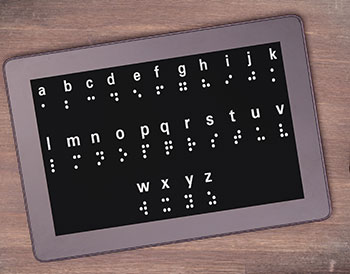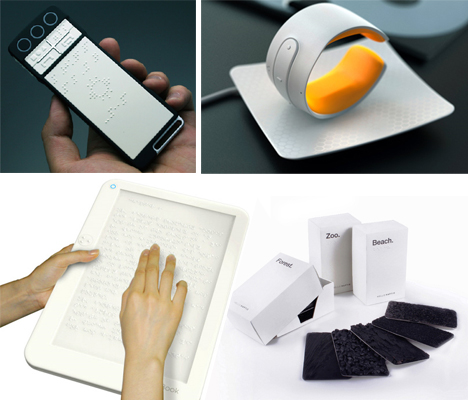Mobility Aids for Visually Impaired Users: Improving Freedom
Wiki Article
Discover Ingenious Tools Made for the Aesthetically Impaired
The development of cutting-edge devices for the aesthetically impaired represents a substantial development in ease of access and self-reliance. Technologies such as wise glasses with AI capacities and mobile applications created to provide auditory descriptions are reshaping day-to-day experiences for users.Smart Glasses for Navigation

Smart glasses designed for navigation are revolutionizing the means aesthetically impaired individuals engage with their environment. These sophisticated devices utilize a mix of cam innovation, expert system, and auditory responses to provide real-time details regarding surroundings. By employing obstacle detection systems, wise glasses can notify customers to possible risks, allowing more secure mobility in both unfamiliar and familiar setups.
The integration of GPS innovation better improves navigation abilities, allowing users to receive acoustic directions as they relocate. This hands-free approach not just cultivates self-reliance but additionally empowers visually impaired people to navigate city landscapes with enhanced confidence. Additionally, lots of smart glasses are outfitted with functions that recognize landmarks and road indications, providing contextual details that enhances the user experience.
Additionally, the growth of these gadgets is continually advancing, with business working to improve the precision of item recognition and broaden the variety of navigational functions. As wise glasses come to be much more budget friendly and accessible, they hold the possible to significantly change every day life for aesthetically impaired individuals. Ultimately, these ingenious tools represent an essential step toward inclusivity, offering improved flexibility and a greater feeling of autonomy for individuals navigating the world around them.

Mobile Application for Daily Living
Exactly how can mobile applications improve the daily lives of aesthetically damaged people? Mobile apps are revolutionizing the method aesthetically impaired users browse their settings, take care of day-to-day tasks, and access info. These applications provide vital support through numerous capabilities, fostering freedom and enhancing high quality of life.A number of cutting-edge mobile applications are designed particularly for day-to-day living. For example, apps like Be My Eyes link visually impaired users with sighted volunteers using video clip phone calls, permitting them to get real-time aid with tasks such as checking out tags or browsing strange spaces. Seeing AI, created by Microsoft, utilizes man-made knowledge to describe surroundings, read text, and identify items, properly changing a mobile phone right into an effective tool for everyday help.
In addition, navigating apps customized for the visually impaired, such as Aira and BlindSquare, use audio-based instructions and ecological details, making it possible for customers to traverse their surroundings securely and confidently. Past navigating and instant aid, mobile apps also support organization and task administration, with features that aid customers establish tips, produce to-do checklists, and track consultations. In summary, mobile applications act as important sources, equipping visually impaired individuals to lead even more independent and fulfilling lives.
Wearable Technologies for Help
Empowerment through technology is increasingly noticeable in the world of wearable devices created to aid aesthetically damaged people. These ingenious tools integrate perfectly into life, improving navigating and giving essential feedback to individuals. As an example, wise glasses outfitted with video cameras can read and recognize faces message aloud, permitting customers to communicate more with confidence in professional and social settings.Another remarkable development is using haptic comments systems in wearable gadgets. These systems use resonances or other tactile signals to communicate details regarding the user's environment, such as obstacles or adjustments in terrain, boosting mobility and security. Wearable innovations also include wristbands that link to smartphones, informing customers to notifications via subtle resonances, therefore boosting connection without dependence on visual cues.
As these modern technologies proceed to develop, they are not only improving independence for visually impaired people but likewise promoting a better sense of inclusion in society. By linking the space between challenges faced in daily living and the potential for freedom, wearable technologies function as crucial tools in the pursuit for equality and empowerment for those with visual impairments.
Audio Summary Devices
Sound description tools play an important role in enhancing access for aesthetically damaged people, supplying them with the ability to engage with aesthetic media. Voice-activated assistive devices. These tools use narrated summaries of key visual aspects in films, television shows, and live performances, ensuring that customers can fully understand the context and emotions shared with visualsSound summary can be integrated right into various systems, including streaming services, movie theater screenings, and live cinema. Many popular streaming services now consist of audio summary as an availability attribute, enabling visitors to choose it easily. Along with conventional media, specialized apps additionally exist, offering audio summaries for art exhibits, museums, and various other cultural occasions.
The efficiency of audio description rests on the skill of the narrators, who should communicate aesthetic details succinctly without interfering with the initial audio. Technologies in this field are also leading the means for more personalized experiences, where individuals can adjust the level of detail and pacing according to their preferences.
Braille Innovations and Devices
Braille developments and devices have actually dramatically changed the method aesthetically damaged individuals connect with message and info. Modern advancements have led to the growth of flexible devices that improve proficiency and independence among customers.
Furthermore, portable Braille notetakers incorporate typical Braille input with modern-day functionalities, facilitating note-taking, scheduling, and record editing on the go. Assistive technology for the blind. These portable devices often feature text-to-speech capabilities, bridging the gap in between Braille and auditory information
In enhancement, cutting-edge Braille printers have actually arised, allowing individuals to create Braille tags, files, and educational materials efficiently. This ease of access promotes greater participation in instructional and professional environments, inevitably promoting inclusivity.
Additionally, research into wise Braille innovations remains to expand. Tools that include synthetic knowledge are being checked out to offer real-time navigation assistance and contextual details, boosting the user experience in varied settings. Generally, these innovations reflect a commitment to empowering visually impaired people through modern technology, guaranteeing they Screen readers for the blind can easily gain access to and involve with the world around them.

Verdict
The innovation of cutting-edge devices for the visually impaired considerably improves self-reliance and top quality of life. These modern technologies not only foster better addition however also advertise freedom in everyday activities, eventually adding to an extra equitable and easily accessible society for aesthetically impaired individuals.As smart glasses become extra obtainable and inexpensive, they hold the prospective to dramatically transform everyday life for visually impaired individuals. Mobile applications are revolutionizing the way aesthetically impaired individuals browse their environments, take care of everyday jobs, and accessibility information. Apps like Be My Eyes link aesthetically impaired users with sighted volunteers through video clip calls, allowing them to get real-time support with tasks such as checking out tags or browsing unfamiliar rooms.Furthermore, navigation applications tailored for the aesthetically damaged, such as Aira and BlindSquare, supply audio-based directions and environmental details, allowing individuals to traverse their surroundings securely and with confidence.The development of ingenious devices for the aesthetically impaired significantly improves self-reliance and quality of life.
Report this wiki page